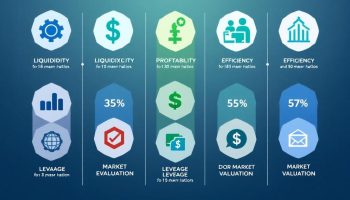![]()
KPI Monitoring: An Essential Tool for Success
KPI monitoring tracks key performance indicators to measure progress toward business goals and identify improvement areas. This process includes selecting relevant metrics, setting up data collection systems, visualizing data, and conducting regular performance reviews to drive better decision-making and organizational success.
Why Businesses Need Effective KPI Monitoring
KPI monitoring acts as a compass guiding your organizational strategy and operational excellence in today’s data-driven business environment. Without proper monitoring systems, companies operate blindly, basing decisions on gut feelings instead of evidence. Effective KPI monitoring helps leadership quickly spot performance gaps, distribute resources efficiently, and respond to market changes with agility.
It creates accountability across departments by providing clear measurement of progress toward strategic objectives. When implemented correctly, KPI monitoring converts raw data into actionable insights that fuel continuous improvement and competitive advantage. This makes it an essential practice for organizations aiming for sustainable growth and operational excellence.
Your ability to track performance metrics consistently can mean the difference between strategic success and missed opportunities. Regular monitoring helps you stay on target with your business goals while providing early warning signs when things aren’t going as planned.
Companies that effectively use data and analytics can improve their profit margins by 5 to 6 percent.
6 Key Steps for Effective KPI Monitoring: Optimize Your Performance Strategy Today
In today’s data-driven landscape, effective KPI monitoring is essential for guiding your business strategy and driving sustainable growth. This section unveils six crucial steps that can enhance your KPI monitoring processes, ensuring you select relevant indicators, establish solid data collection frameworks, and create comprehensive reporting systems. Each step is designed to provide actionable insights that not only keep your team aligned but also foster accountability across departments. By implementing these strategies, you will ensure that your performance metrics are not just numbers on a dashboard, but powerful tools that inform decisions and improve outcomes. Read on to discover how you can optimize your approach to KPI monitoring and elevate your business performance.
1. Strategic KPI Selection
Effective KPI monitoring starts with selecting the right metrics to track. When identifying your key performance indicators, align them directly with your business objectives to ensure they drive meaningful outcomes. KPI monitoring becomes significantly more valuable when you focus on actionable indicators that prompt specific improvements rather than just reporting numbers.
Avoid vanity metrics that look impressive but don’t offer actionable insights for your business performance. Instead, establish clear measurement criteria that everyone understands and agrees upon. This creates a solid foundation for consistent tracking and evaluation.
Consider these elements when selecting your KPIs:
- Direct connection to strategic goals
- Clear ownership and accountability
- Quantifiable and measurable values
- Realistic timeframes for achievement
- Relevance to specific business functions
Remember that strategic planning should inform which KPIs matter most. The strongest monitoring frameworks include a balanced mix of leading indicators (predicting future performance) and lagging indicators (measuring past results).
2. Data Collection Infrastructure
Effective KPI monitoring begins with a robust data collection infrastructure. You need systems that automatically gather performance data to eliminate manual errors and save valuable time. When implementing KPI monitoring tools, ensure they provide accurate and consistent information across all business units.
Real-time monitoring capabilities are essential for making timely decisions based on current performance metrics. Your data collection systems should update continuously, allowing you to spot trends and address issues before they impact business outcomes. Many organizations struggle with post-hoc management because their monitoring systems lack immediacy.
Integrating multiple data sources creates a comprehensive view of performance across your organization. Consider these integration approaches:
- API connections between platforms to automatically sync data
- Data warehouse solutions that centralize information from various systems
- ETL (Extract, Transform, Load) processes to standardize data formats
- Cloud-based integration services for real-time synchronization
The success of your project collaboration efforts often depends on how effectively team members can access and work with shared KPI data.
Expert Insight: To enhance KPI monitoring, establish a strong data collection infrastructure that automates data gathering and ensures accuracy across business units. Utilize real-time monitoring and integrate multiple data sources for comprehensive insights, allowing timely decisions and effective project collaboration. This proactive approach mitigates the risks of post-hoc management.
3. Visualization and Reporting Framework for Effective KPI Monitoring
Effective KPI monitoring requires a robust visualization and reporting framework that transforms raw data into actionable insights. When you implement this framework correctly, it becomes significantly easier to track performance metrics and make data-driven decisions.
Creating intuitive dashboards is fundamental to successful KPI monitoring. These dashboards should display key metrics in a visually appealing way that enables quick comprehension. Choose visualization elements that best represent your data—whether it’s line charts for trends, bar graphs for comparisons, or gauge charts for progress against targets.
Standardizing report formats ensures consistency across your organization. When developing these standards, consider:
- Clear labeling of metrics and time periods
- Consistent color coding for performance indicators
- Uniform layout structures across departments
- Regular updating schedules
Implementing drill-down capabilities allows users to navigate performance metrics at varying levels of detail. This functionality enables stakeholders to investigate anomalies by examining the underlying data components.
Enabling customizable views for different stakeholders recognizes that various team members have different KPI monitoring needs. For example, executives may need high-level summaries while operational managers require detailed metrics specific to their departments.
Expert Insight: To enhance KPI monitoring, develop intuitive dashboards with clear labeling and consistent formats. Implement drill-down capabilities for in-depth analysis and customize views to meet the diverse needs of stakeholders. This approach transforms data into actionable insights, facilitating data-driven decision-making across your organization.
4. Regular Performance Review Cycles
Effective KPI monitoring requires establishing systematic review cycles to track progress consistently. When you implement regular performance reviews, you create a structure that supports ongoing measurement and accountability. These cycles are vital touchpoints for assessing how well your KPI monitoring activities are capturing meaningful performance data.
Start by determining the optimal frequency for your reviews based on your business dynamics and the nature of your KPIs. Daily monitoring works best for operational metrics, while strategic KPIs might need monthly or quarterly assessment. Set up threshold alerts within your monitoring system to notify stakeholders when metrics deviate significantly from targets, enabling proactive issue management before problems escalate.
Conducting trend analysis is another crucial component of your review cycles. Look beyond isolated data points to identify patterns that reveal deeper insights about performance trajectories. Consider these trend analysis techniques:
- Moving averages to smooth out short-term fluctuations
- Year-over-year comparisons to account for seasonality
- Regression analysis to identify correlations between variables
- Forecasting models to predict future performance
Document all performance variations thoroughly, recording not just the numbers but contextual factors that might explain deviations from expectations. This documentation creates an invaluable historical record for continuous improvement efforts.
Expert Insight: Implement regular performance review cycles to ensure consistent KPI monitoring and accountability. Tailor the frequency of reviews to your business needs, and utilize trend analysis to uncover insights. Document variations thoroughly to support continuous improvement, making historical data a valuable resource for future strategic decisions.
5. Cross-functional Alignment for Effective KPI Monitoring
Successful KPI monitoring requires alignment across all departments to ensure everyone is working toward common goals. When implementing your monitoring systems, establish clear ownership of specific KPIs to avoid confusion about who’s responsible for tracking and improving them. Effective KPI monitoring happens when accountability is distributed appropriately across teams.
Create shared performance goals that connect different departments around key metrics. This collaborative approach to KPI monitoring encourages cross-departmental cooperation rather than siloed thinking. When marketing, sales, and customer service teams all focus on improving customer retention KPIs, they naturally collaborate more effectively.
Establish dedicated communication channels for discussing KPI performance and insights. These might include regular cross-functional collaboration meetings or shared digital workspaces where teams can discuss metric trends. Without these channels, valuable insights from your KPI monitoring efforts might not reach everyone who needs them.
Finally, coordinate response actions when KPIs fall outside acceptable ranges. Develop protocols that specify:
- Who must be notified
- What immediate actions should be taken
- How to document the intervention
- When to escalate issues to leadership
Expert Insight: Ensure cross-functional alignment in KPI monitoring by establishing clear ownership of metrics and creating shared goals that unite departments. Foster collaboration through dedicated communication channels for discussing performance insights, and develop protocols for coordinated responses when KPIs deviate, ensuring accountability and swift action across teams.
6. Continuous Optimization Process
Effective KPI monitoring requires ongoing refinement to maintain relevance and accuracy. Implementing feedback loops is essential to your KPI monitoring system, allowing you to capture insights from stakeholders who use the metrics daily. These loops help identify when indicators no longer serve their intended purpose.
As your business evolves, adjusting metrics based on organizational changes becomes crucial. Your KPIs should reflect your current priorities, not outdated objectives. Consider these approaches to optimization:
- Regular review sessions to evaluate KPI effectiveness
- Stakeholder surveys to gather improvement suggestions
- A/B testing of alternative metrics before full implementation
- Documentation of metric adjustments and their rationale
Benchmarking against industry standards provides valuable context for your performance indicators. Through continuous improvement methodologies, you can identify opportunities to enhance your tracking processes.
Updating tracking methodologies ensures you’re using the most effective tools and approaches. As analytics capabilities advance, your KPI monitoring should incorporate new technologies that offer deeper insights or more efficient measurement processes.
KPI Monitoring: A Systematic Approach
KPI monitoring is a systematic process that tracks, measures, and evaluates key performance indicators to ensure organizational goals are being met. It encompasses six essential elements—strategic KPI selection, data collection infrastructure, visualization frameworks, performance review cycles, cross-functional alignment, and continuous optimization processes—that together create a comprehensive performance management system.
The Importance of KPI Monitoring
KPI monitoring empowers enterprise organizations to make data-driven decisions by providing real-time insights into business performance across all departments. By implementing effective monitoring systems, companies can quickly:
- Identify trends
- Address potential issues before they escalate
- Align teams around common objectives
- Continuously improve their operational efficiency
This ultimately drives better business outcomes and maintains a competitive advantage in today’s data-centric business environment.






